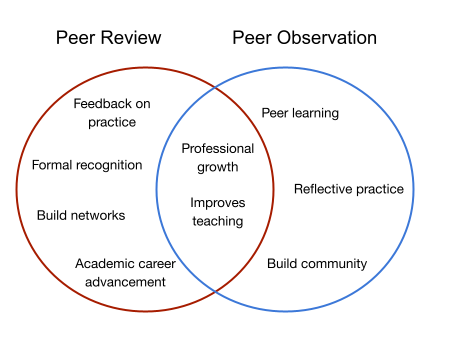Tutors are often the first point of contact for our students, playing a crucial role in their learning journey. However, these educators, especially those new to the role, don’t always receive ample opportunities to develop their teaching practice. This gap in support can leave tutors feeling underprepared and isolated as they navigate the challenges of their new identity.
To address this issue and empower our tutors, several schools and faculties across the University of Sydney are adopting local peer observation programs. These initiatives complement our well-established Peer Review for Teaching (PRT) program, focusing specifically on supporting and training casual tutors and educators.
The primary goal of peer observation programs is to create a supportive, low-stakes environment for tutor development in a non-judgmental setting. By observing experienced tutors in action, creating an opportunity to reflect and talk to fellow educators about their practice junior tutors can gain confidence, learn effective teaching strategies, and feel more prepared for their own classes.
In this post, we’ll explore peer observation: what it is, how it benefits tutors, key features that make these programs effective, and why you might consider implementing peer observation in your own teaching context. This will set the stage for our next post, which will showcase diverse approaches to peer observation across the University of Sydney, demonstrating *how* this practice can be adapted to various educational settings.
Is Peer Review the same as Peer Observation?
Peer review typically involves a more experienced educator evaluating and providing feedback on a colleague’s teaching while peer observation focuses on reflective learning through observation of another, perhaps more experienced, educator.

The literature recognises both peer review and peer observation of teaching as effective methods for sharing best educational practices. However, these approaches differ in their approach/operation and serve distinct, albeit overlapping, purposes.
Peer observation is often useful as a low-stakes introduction to the peer review/peer observation process, making it particularly suitable for both teaching teams and tutor development programs.
Prioritising peer observation, programs foster a collaborative learning environment that emphasises personal and professional growth rather than performance-based assessment.
In its lightest form, peer observation may be taken up by teaching teams through the practice of “sitting-in” on each other’s classes, with the aim to watch and learn without additional procedure or admin.
Why focus on Peer Observation for tutors?
Peer observation programs offer valuable opportunities for tutors to enhance their teaching practice. The process of observing and being observed can significantly boost tutors’ confidence in their teaching skills, while also introducing them to diverse and effective teaching strategies.
Tutors particularly benefit from programs focused on observation rather than review, gaining insights from both observing and being observed. To maximise participation and effectiveness, programs should be conducted regularly and maintain a non-judgmental, development-oriented approach. This supportive environment encourages tutors to engage fully in the process, leading to meaningful improvements in teaching quality across the institution.
What makes an effective Peer Observation program?
Must-haves
While local adaptations will look a little different in each context, there are some core features common to successful peer observation programs:
| Paid participation: |
|
| Scaffolded structure: |
|
| Clear, evidence-based observation proforma: |
|
| Supported process: |
|
| Time considerate: |
|
| Non-judgmental approach: |
|
Nice to have
In addition to the must-haves, successful programs (where possible) often include some/all of these features:
- In-person introduction and debriefing sessions (paid)
- Opportunities for the observer and observee to meet before and after the observation
- Integration with broader professional development initiatives
- Use of technology platforms (e.g., Canvas, Discussion boards) for coordination and idea sharing
- Recognition of participation (e.g., certificates)
- Opportunities to observe multiple peers or be observed multiple times
Interested in running a Peer Observation program in your own context?
Implementing a peer observation program can significantly enhance teaching quality and tutor development. However, it also comes with its own set of challenges. Here’s an overview of the key benefits and challenges:
| Benefits | Challenges |
|
|
While these challenges may seem daunting, many units/schools/faculties at the University of Sydney have successfully implemented peer observation programs, adapting the process to suit their specific needs and contexts.
Implementing Peer Observation: learn more and get started
Explore peer observation programs at Sydney
Learn from successful implementations across the university by reading our companion post, “Tailoring peer observation for your tutors at Sydney“. This article showcases how different units/schools/faculties have adapted peer observation to meet their specific needs.
Ready to start planning your own peer observation program?
We’re here to help. Please reach out to Educational Innovation for guidance and support: [email protected]
Take it to the next level with Peer Review for Teaching
Once your tutors have gained experience with peer observation, they might be ready to take the next step: Peer Review for Teaching. Learn more about the Peer Review for Teaching program at Sydney, including how you or your tutors can sign up for your own review: Receive personalised expert review and support for your teaching






1 Comment